Cancer Management: A Study of Radiotherapy & Chemotherapy Efficacy
VerifiedAdded on 2023/06/03
|7
|1317
|405
Report
AI Summary
This report explores cancer management and treatment strategies, focusing on radiotherapy and chemotherapy. It outlines a research plan involving 200 cancer patients from Wellington Regional Hospital over an 18-month period. The study aims to determine if a combination of radiotherapy and chemotherapy improves recovery rates and reduces cancer spread compared to individual treatments. Statistical hypotheses are presented, and a one-tailed Z test is proposed for data analysis, considering variables like patient ID, treatment type, recovery probability, and percentage spread of cancer. Sample size justification is provided, aiming for at least 30 patients per treatment group to ensure statistical power. The report concludes by emphasizing the importance of the research objectives and the statistical methods employed.
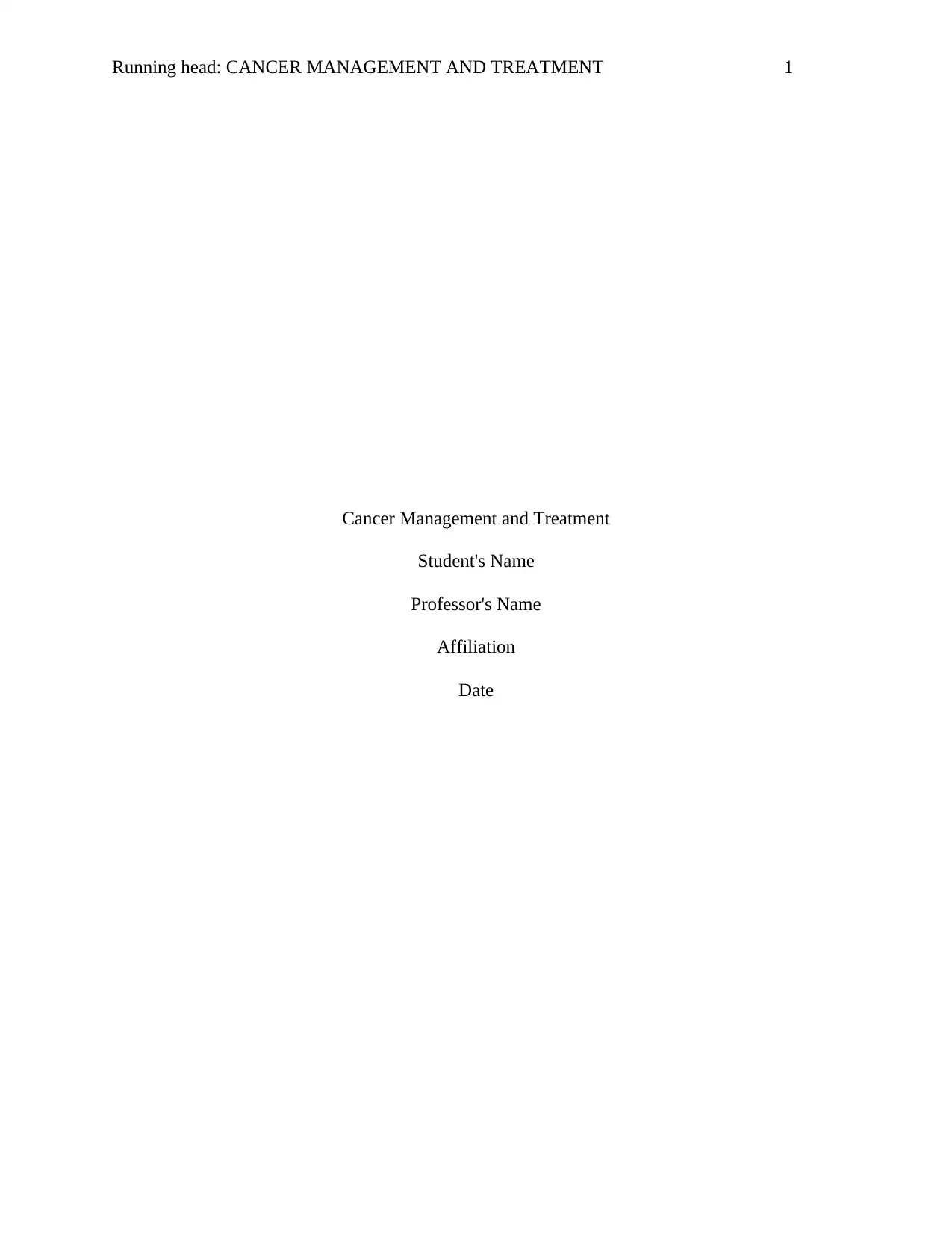
Running head: CANCER MANAGEMENT AND TREATMENT 1
Cancer Management and Treatment
Student's Name
Professor's Name
Affiliation
Date
Cancer Management and Treatment
Student's Name
Professor's Name
Affiliation
Date
Paraphrase This Document
Need a fresh take? Get an instant paraphrase of this document with our AI Paraphraser
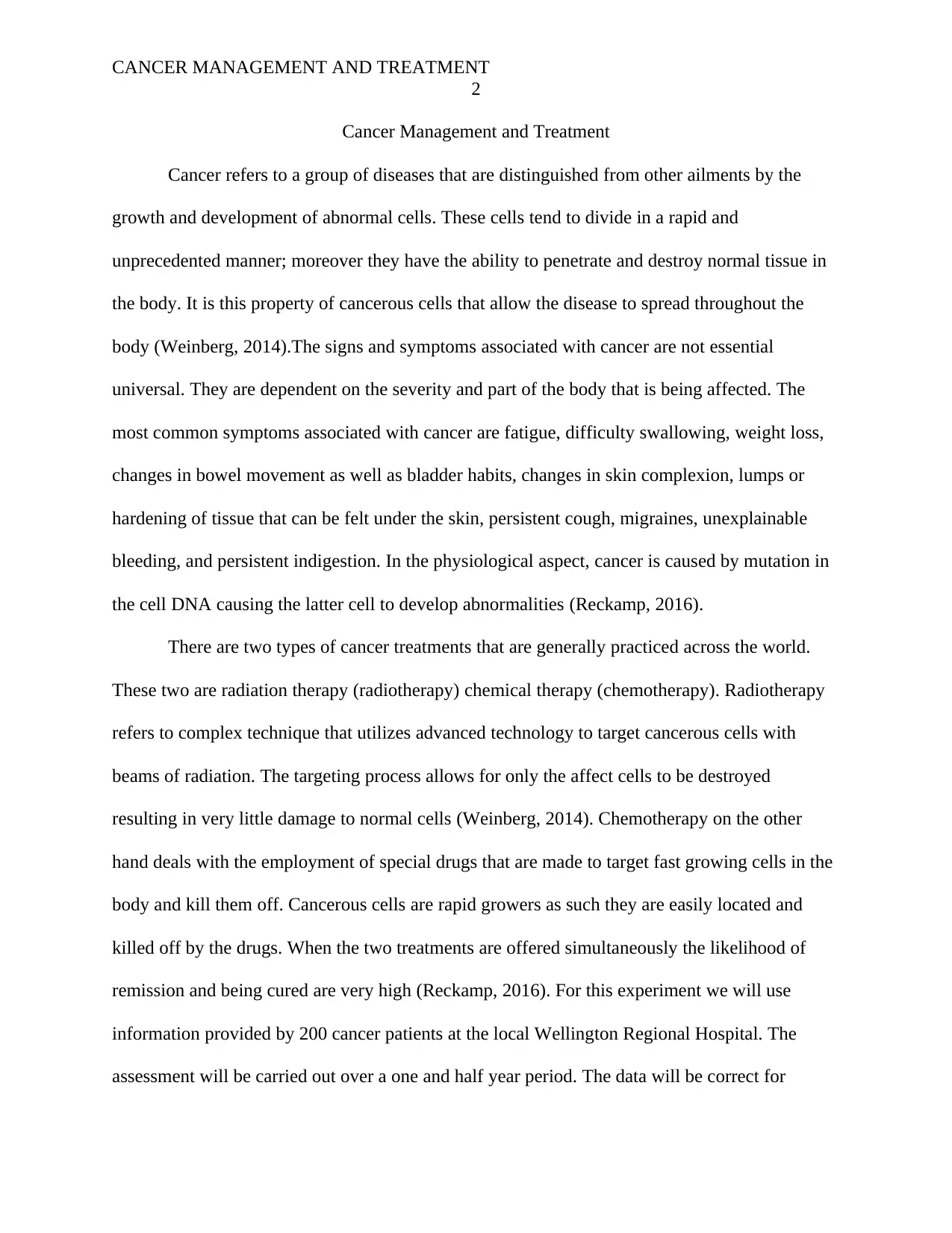
CANCER MANAGEMENT AND TREATMENT
2
Cancer Management and Treatment
Cancer refers to a group of diseases that are distinguished from other ailments by the
growth and development of abnormal cells. These cells tend to divide in a rapid and
unprecedented manner; moreover they have the ability to penetrate and destroy normal tissue in
the body. It is this property of cancerous cells that allow the disease to spread throughout the
body (Weinberg, 2014).The signs and symptoms associated with cancer are not essential
universal. They are dependent on the severity and part of the body that is being affected. The
most common symptoms associated with cancer are fatigue, difficulty swallowing, weight loss,
changes in bowel movement as well as bladder habits, changes in skin complexion, lumps or
hardening of tissue that can be felt under the skin, persistent cough, migraines, unexplainable
bleeding, and persistent indigestion. In the physiological aspect, cancer is caused by mutation in
the cell DNA causing the latter cell to develop abnormalities (Reckamp, 2016).
There are two types of cancer treatments that are generally practiced across the world.
These two are radiation therapy (radiotherapy) chemical therapy (chemotherapy). Radiotherapy
refers to complex technique that utilizes advanced technology to target cancerous cells with
beams of radiation. The targeting process allows for only the affect cells to be destroyed
resulting in very little damage to normal cells (Weinberg, 2014). Chemotherapy on the other
hand deals with the employment of special drugs that are made to target fast growing cells in the
body and kill them off. Cancerous cells are rapid growers as such they are easily located and
killed off by the drugs. When the two treatments are offered simultaneously the likelihood of
remission and being cured are very high (Reckamp, 2016). For this experiment we will use
information provided by 200 cancer patients at the local Wellington Regional Hospital. The
assessment will be carried out over a one and half year period. The data will be correct for
2
Cancer Management and Treatment
Cancer refers to a group of diseases that are distinguished from other ailments by the
growth and development of abnormal cells. These cells tend to divide in a rapid and
unprecedented manner; moreover they have the ability to penetrate and destroy normal tissue in
the body. It is this property of cancerous cells that allow the disease to spread throughout the
body (Weinberg, 2014).The signs and symptoms associated with cancer are not essential
universal. They are dependent on the severity and part of the body that is being affected. The
most common symptoms associated with cancer are fatigue, difficulty swallowing, weight loss,
changes in bowel movement as well as bladder habits, changes in skin complexion, lumps or
hardening of tissue that can be felt under the skin, persistent cough, migraines, unexplainable
bleeding, and persistent indigestion. In the physiological aspect, cancer is caused by mutation in
the cell DNA causing the latter cell to develop abnormalities (Reckamp, 2016).
There are two types of cancer treatments that are generally practiced across the world.
These two are radiation therapy (radiotherapy) chemical therapy (chemotherapy). Radiotherapy
refers to complex technique that utilizes advanced technology to target cancerous cells with
beams of radiation. The targeting process allows for only the affect cells to be destroyed
resulting in very little damage to normal cells (Weinberg, 2014). Chemotherapy on the other
hand deals with the employment of special drugs that are made to target fast growing cells in the
body and kill them off. Cancerous cells are rapid growers as such they are easily located and
killed off by the drugs. When the two treatments are offered simultaneously the likelihood of
remission and being cured are very high (Reckamp, 2016). For this experiment we will use
information provided by 200 cancer patients at the local Wellington Regional Hospital. The
assessment will be carried out over a one and half year period. The data will be correct for
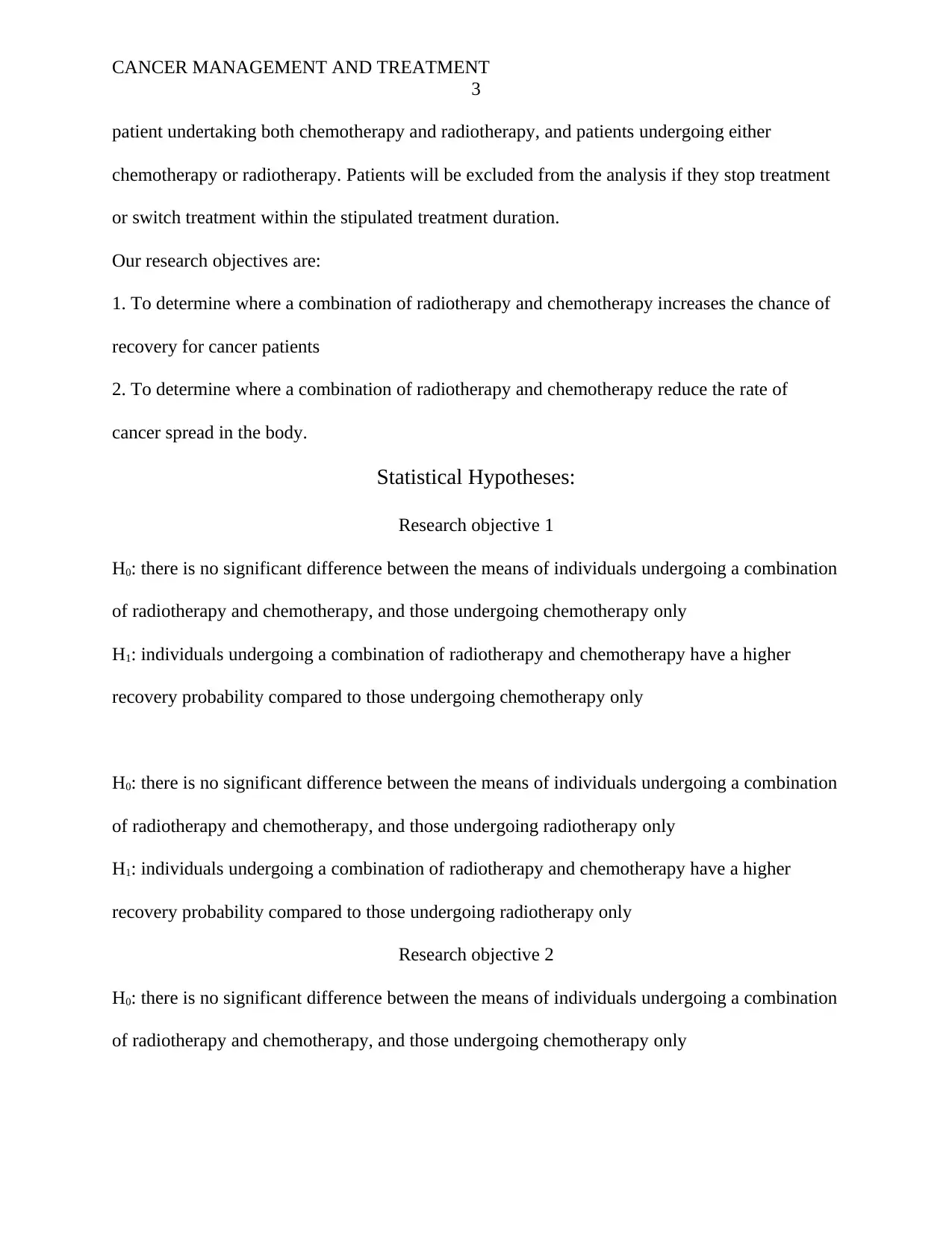
CANCER MANAGEMENT AND TREATMENT
3
patient undertaking both chemotherapy and radiotherapy, and patients undergoing either
chemotherapy or radiotherapy. Patients will be excluded from the analysis if they stop treatment
or switch treatment within the stipulated treatment duration.
Our research objectives are:
1. To determine where a combination of radiotherapy and chemotherapy increases the chance of
recovery for cancer patients
2. To determine where a combination of radiotherapy and chemotherapy reduce the rate of
cancer spread in the body.
Statistical Hypotheses:
Research objective 1
H0: there is no significant difference between the means of individuals undergoing a combination
of radiotherapy and chemotherapy, and those undergoing chemotherapy only
H1: individuals undergoing a combination of radiotherapy and chemotherapy have a higher
recovery probability compared to those undergoing chemotherapy only
H0: there is no significant difference between the means of individuals undergoing a combination
of radiotherapy and chemotherapy, and those undergoing radiotherapy only
H1: individuals undergoing a combination of radiotherapy and chemotherapy have a higher
recovery probability compared to those undergoing radiotherapy only
Research objective 2
H0: there is no significant difference between the means of individuals undergoing a combination
of radiotherapy and chemotherapy, and those undergoing chemotherapy only
3
patient undertaking both chemotherapy and radiotherapy, and patients undergoing either
chemotherapy or radiotherapy. Patients will be excluded from the analysis if they stop treatment
or switch treatment within the stipulated treatment duration.
Our research objectives are:
1. To determine where a combination of radiotherapy and chemotherapy increases the chance of
recovery for cancer patients
2. To determine where a combination of radiotherapy and chemotherapy reduce the rate of
cancer spread in the body.
Statistical Hypotheses:
Research objective 1
H0: there is no significant difference between the means of individuals undergoing a combination
of radiotherapy and chemotherapy, and those undergoing chemotherapy only
H1: individuals undergoing a combination of radiotherapy and chemotherapy have a higher
recovery probability compared to those undergoing chemotherapy only
H0: there is no significant difference between the means of individuals undergoing a combination
of radiotherapy and chemotherapy, and those undergoing radiotherapy only
H1: individuals undergoing a combination of radiotherapy and chemotherapy have a higher
recovery probability compared to those undergoing radiotherapy only
Research objective 2
H0: there is no significant difference between the means of individuals undergoing a combination
of radiotherapy and chemotherapy, and those undergoing chemotherapy only
⊘ This is a preview!⊘
Do you want full access?
Subscribe today to unlock all pages.

Trusted by 1+ million students worldwide
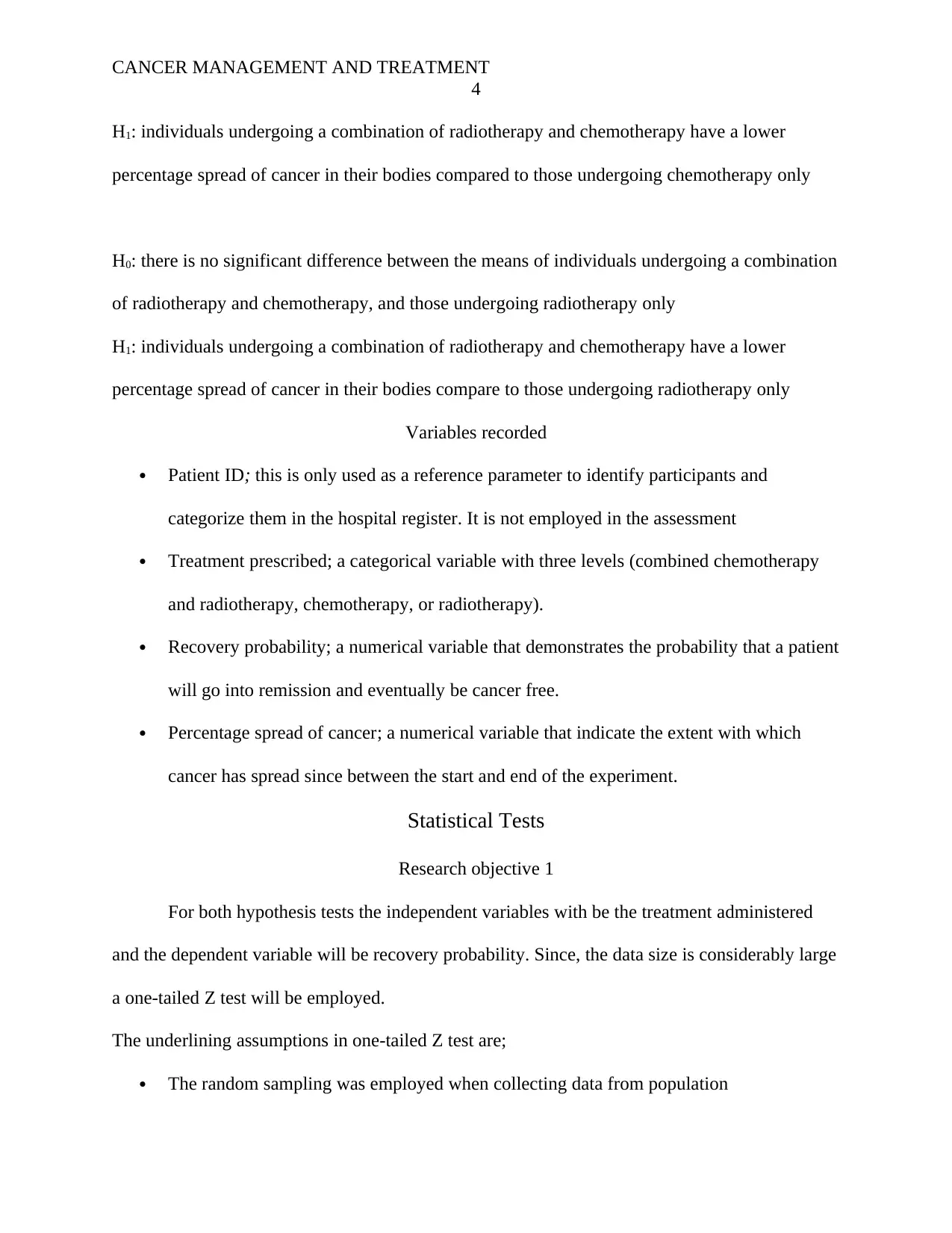
CANCER MANAGEMENT AND TREATMENT
4
H1: individuals undergoing a combination of radiotherapy and chemotherapy have a lower
percentage spread of cancer in their bodies compared to those undergoing chemotherapy only
H0: there is no significant difference between the means of individuals undergoing a combination
of radiotherapy and chemotherapy, and those undergoing radiotherapy only
H1: individuals undergoing a combination of radiotherapy and chemotherapy have a lower
percentage spread of cancer in their bodies compare to those undergoing radiotherapy only
Variables recorded
Patient ID; this is only used as a reference parameter to identify participants and
categorize them in the hospital register. It is not employed in the assessment
Treatment prescribed; a categorical variable with three levels (combined chemotherapy
and radiotherapy, chemotherapy, or radiotherapy).
Recovery probability; a numerical variable that demonstrates the probability that a patient
will go into remission and eventually be cancer free.
Percentage spread of cancer; a numerical variable that indicate the extent with which
cancer has spread since between the start and end of the experiment.
Statistical Tests
Research objective 1
For both hypothesis tests the independent variables with be the treatment administered
and the dependent variable will be recovery probability. Since, the data size is considerably large
a one-tailed Z test will be employed.
The underlining assumptions in one-tailed Z test are;
The random sampling was employed when collecting data from population
4
H1: individuals undergoing a combination of radiotherapy and chemotherapy have a lower
percentage spread of cancer in their bodies compared to those undergoing chemotherapy only
H0: there is no significant difference between the means of individuals undergoing a combination
of radiotherapy and chemotherapy, and those undergoing radiotherapy only
H1: individuals undergoing a combination of radiotherapy and chemotherapy have a lower
percentage spread of cancer in their bodies compare to those undergoing radiotherapy only
Variables recorded
Patient ID; this is only used as a reference parameter to identify participants and
categorize them in the hospital register. It is not employed in the assessment
Treatment prescribed; a categorical variable with three levels (combined chemotherapy
and radiotherapy, chemotherapy, or radiotherapy).
Recovery probability; a numerical variable that demonstrates the probability that a patient
will go into remission and eventually be cancer free.
Percentage spread of cancer; a numerical variable that indicate the extent with which
cancer has spread since between the start and end of the experiment.
Statistical Tests
Research objective 1
For both hypothesis tests the independent variables with be the treatment administered
and the dependent variable will be recovery probability. Since, the data size is considerably large
a one-tailed Z test will be employed.
The underlining assumptions in one-tailed Z test are;
The random sampling was employed when collecting data from population
Paraphrase This Document
Need a fresh take? Get an instant paraphrase of this document with our AI Paraphraser
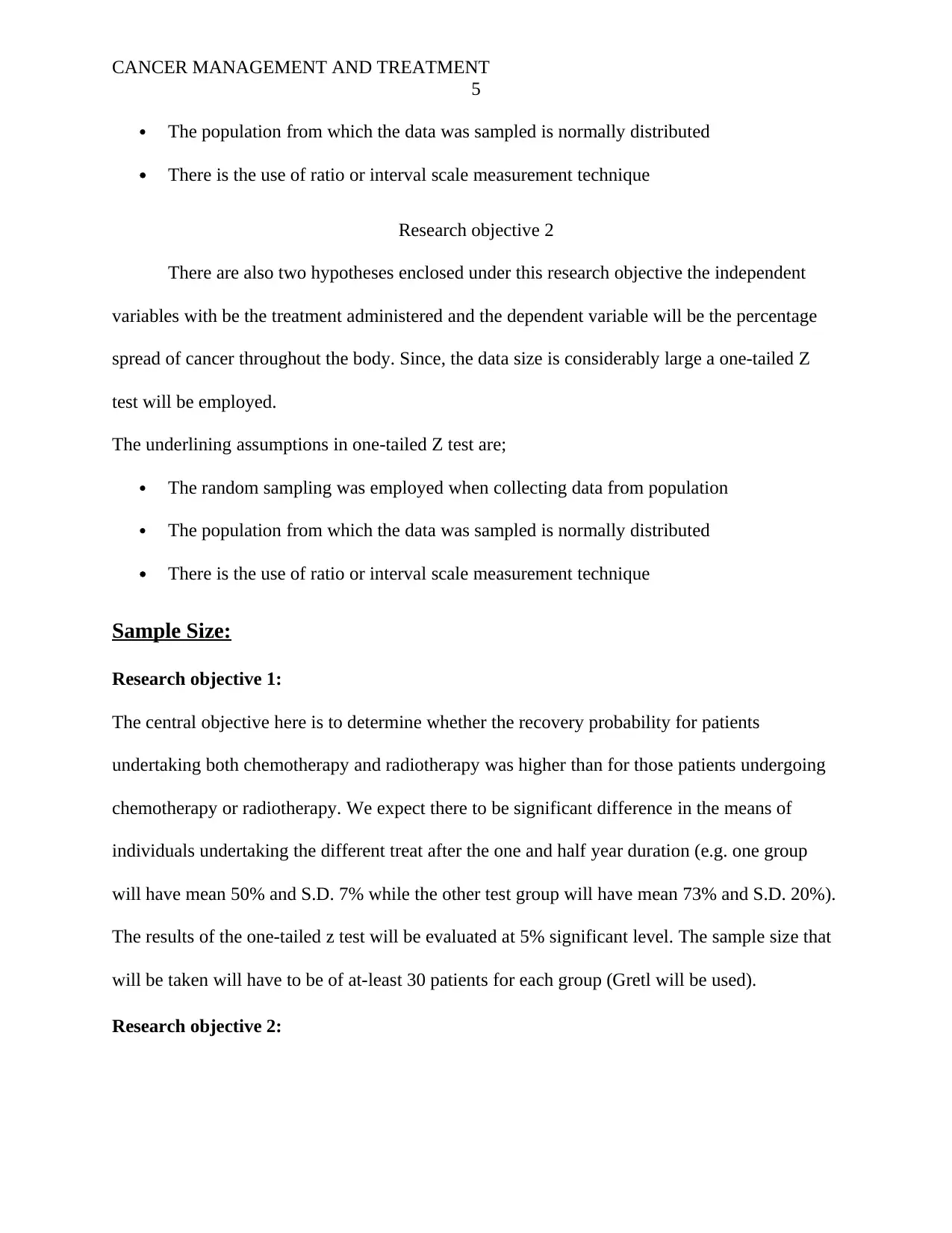
CANCER MANAGEMENT AND TREATMENT
5
The population from which the data was sampled is normally distributed
There is the use of ratio or interval scale measurement technique
Research objective 2
There are also two hypotheses enclosed under this research objective the independent
variables with be the treatment administered and the dependent variable will be the percentage
spread of cancer throughout the body. Since, the data size is considerably large a one-tailed Z
test will be employed.
The underlining assumptions in one-tailed Z test are;
The random sampling was employed when collecting data from population
The population from which the data was sampled is normally distributed
There is the use of ratio or interval scale measurement technique
Sample Size:
Research objective 1:
The central objective here is to determine whether the recovery probability for patients
undertaking both chemotherapy and radiotherapy was higher than for those patients undergoing
chemotherapy or radiotherapy. We expect there to be significant difference in the means of
individuals undertaking the different treat after the one and half year duration (e.g. one group
will have mean 50% and S.D. 7% while the other test group will have mean 73% and S.D. 20%).
The results of the one-tailed z test will be evaluated at 5% significant level. The sample size that
will be taken will have to be of at-least 30 patients for each group (Gretl will be used).
Research objective 2:
5
The population from which the data was sampled is normally distributed
There is the use of ratio or interval scale measurement technique
Research objective 2
There are also two hypotheses enclosed under this research objective the independent
variables with be the treatment administered and the dependent variable will be the percentage
spread of cancer throughout the body. Since, the data size is considerably large a one-tailed Z
test will be employed.
The underlining assumptions in one-tailed Z test are;
The random sampling was employed when collecting data from population
The population from which the data was sampled is normally distributed
There is the use of ratio or interval scale measurement technique
Sample Size:
Research objective 1:
The central objective here is to determine whether the recovery probability for patients
undertaking both chemotherapy and radiotherapy was higher than for those patients undergoing
chemotherapy or radiotherapy. We expect there to be significant difference in the means of
individuals undertaking the different treat after the one and half year duration (e.g. one group
will have mean 50% and S.D. 7% while the other test group will have mean 73% and S.D. 20%).
The results of the one-tailed z test will be evaluated at 5% significant level. The sample size that
will be taken will have to be of at-least 30 patients for each group (Gretl will be used).
Research objective 2:
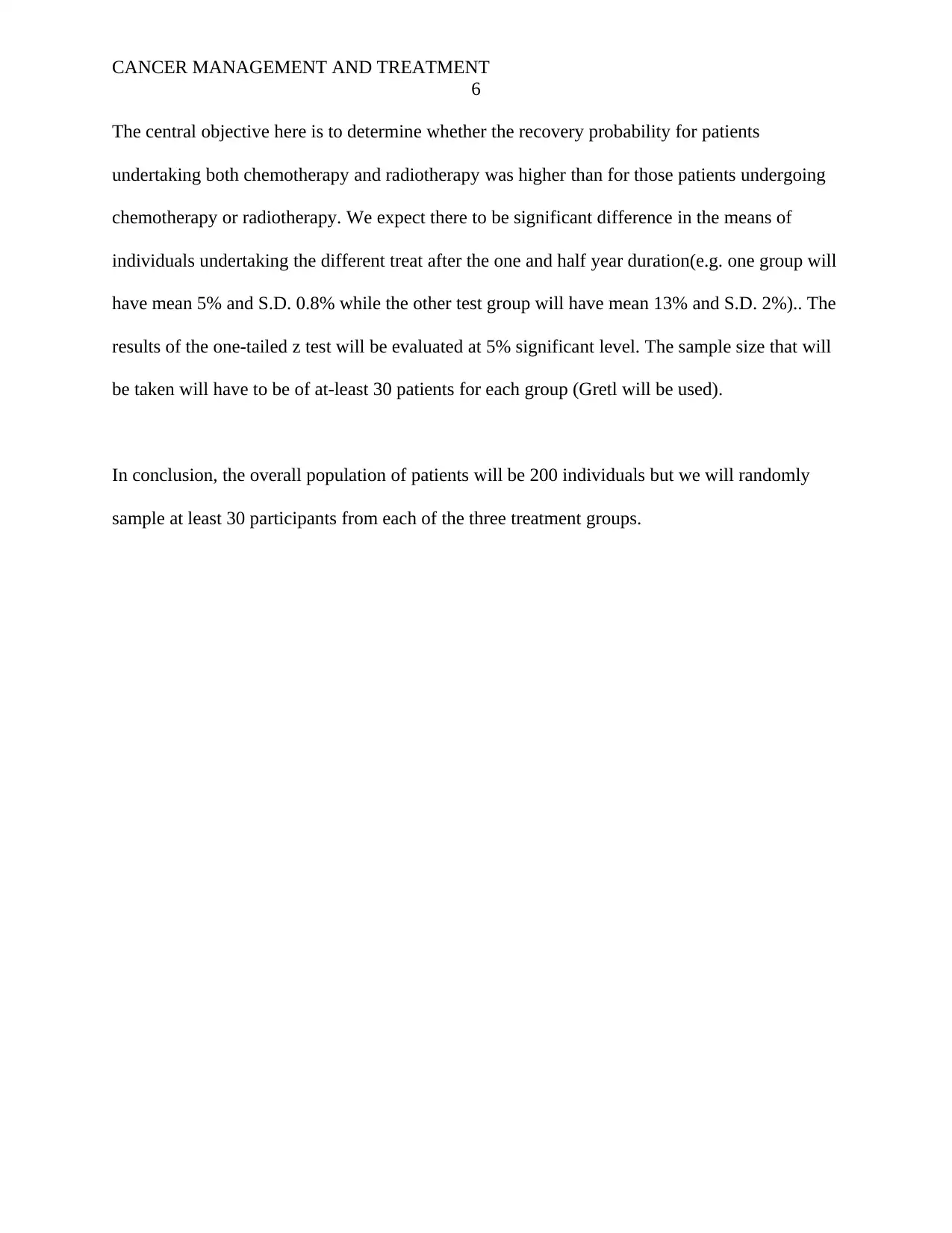
CANCER MANAGEMENT AND TREATMENT
6
The central objective here is to determine whether the recovery probability for patients
undertaking both chemotherapy and radiotherapy was higher than for those patients undergoing
chemotherapy or radiotherapy. We expect there to be significant difference in the means of
individuals undertaking the different treat after the one and half year duration(e.g. one group will
have mean 5% and S.D. 0.8% while the other test group will have mean 13% and S.D. 2%).. The
results of the one-tailed z test will be evaluated at 5% significant level. The sample size that will
be taken will have to be of at-least 30 patients for each group (Gretl will be used).
In conclusion, the overall population of patients will be 200 individuals but we will randomly
sample at least 30 participants from each of the three treatment groups.
6
The central objective here is to determine whether the recovery probability for patients
undertaking both chemotherapy and radiotherapy was higher than for those patients undergoing
chemotherapy or radiotherapy. We expect there to be significant difference in the means of
individuals undertaking the different treat after the one and half year duration(e.g. one group will
have mean 5% and S.D. 0.8% while the other test group will have mean 13% and S.D. 2%).. The
results of the one-tailed z test will be evaluated at 5% significant level. The sample size that will
be taken will have to be of at-least 30 patients for each group (Gretl will be used).
In conclusion, the overall population of patients will be 200 individuals but we will randomly
sample at least 30 participants from each of the three treatment groups.
⊘ This is a preview!⊘
Do you want full access?
Subscribe today to unlock all pages.

Trusted by 1+ million students worldwide
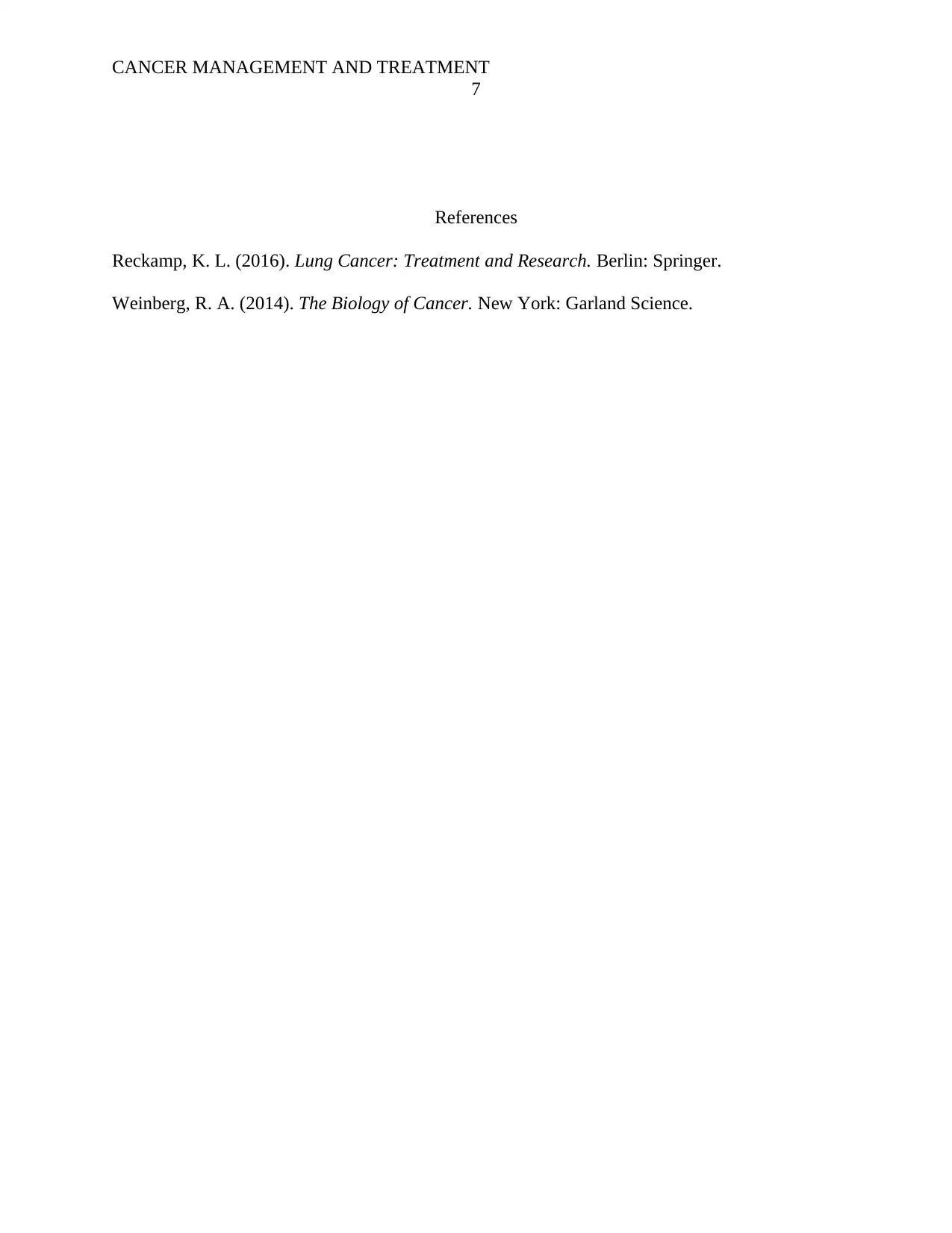
CANCER MANAGEMENT AND TREATMENT
7
References
Reckamp, K. L. (2016). Lung Cancer: Treatment and Research. Berlin: Springer.
Weinberg, R. A. (2014). The Biology of Cancer. New York: Garland Science.
7
References
Reckamp, K. L. (2016). Lung Cancer: Treatment and Research. Berlin: Springer.
Weinberg, R. A. (2014). The Biology of Cancer. New York: Garland Science.
1 out of 7
Related Documents
Your All-in-One AI-Powered Toolkit for Academic Success.
+13062052269
info@desklib.com
Available 24*7 on WhatsApp / Email
![[object Object]](/_next/static/media/star-bottom.7253800d.svg)
Unlock your academic potential
Copyright © 2020–2025 A2Z Services. All Rights Reserved. Developed and managed by ZUCOL.





